All About Lunges: 13 of the Best Variations
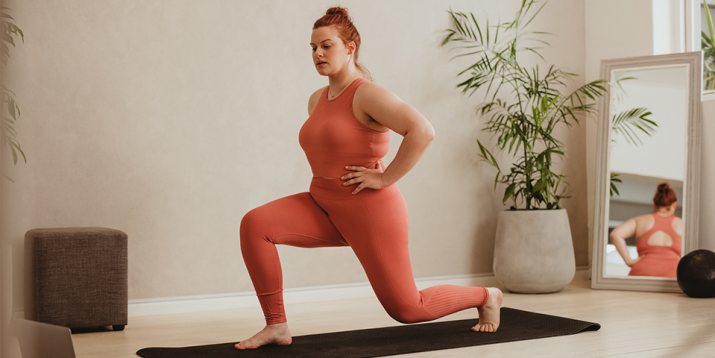
Lunges are often an afterthought when it comes to lower-body exercises. In most workouts (maybe yours?) they typically take a back seat to “bigger” moves such as the squat and deadlift.
That’s about to change. The lunge deserves a place in your workouts just as much as those more popular exercises do, explains Trevor Thieme, C.S.C.S.
While lunges might target the same muscles as those more celebrated exercises, they work them in different ways and offer unique performance benefits. Plus, they can be performed with just your bodyweight or with weights, like dumbbells, kettlebells, or a barbell.
Drop any of a number of these into your workouts to build a stronger, more balanced lower body.
1. Reverse Lunge
Program: Tough Mudder T-MINUS 30
Workout: Extreme Conditioning 1.0
This lunge variation maximizes the activation of the glutes, making it a good choice for anyone who wants to build their backside.
The reverse lunge is also a good option for anyone who experiences knee pain, as people tend to be more stable stepping backwards into a lunge than forward into one.
- Stand tall with your feet hip-width apart, holding a pair of dumbbells at arm’s length by your sides (palms in). This is the starting position.
- Keeping your chest up, back straight, and core engaged, take a large step back with your right foot and lower your body until your front thigh is parallel to the ground (your rear knee should be bent at about a 90-degree angle).
- Pause, and then push off your back foot to reverse the movement and return to the starting position.
- Repeat, this time stepping back with your left foot.
- Continue alternating sides.
2. Walking Lunge
This advanced lunge variation helps build greater stability by requiring you to step forward into each lunge without returning to the starting (standing) position.
- Stand tall with your feet hip-width apart, holding a pair of dumbbells at arm’s length by your sides (palms in). This is the starting position.
- Keeping your chest up, back straight, and core engaged, take a large step forward with your right foot and lower your body until your front thigh is parallel to the floor and your rear knee is bent about 90 degrees.
- Pause, and then push off with your left foot, stepping forward into your next lunge without returning to the starting position.
- Continue alternating legs with each rep/step.
3. Forward Lunge
This classic forward lunge is can help you build and strengthen almost every muscle below your waist.
- Stand tall holding a pair of dumbbells at arm’s length by your sides (palms in) with your feet hip-width apart.
- Keeping your chest up, shoulders back, core engaged, and back flat, take a large step forward with your right foot.
- Lower your body until your front thigh is parallel to the ground and your rear knee is bent about 90 degrees (it should hover a couple of inches above the floor).
- Pause, and then push off your front feet from the heel to reverse the movement and return to the starting position. Repeat, this time stepping forward with your left foot. Continue alternating legs with each rep.
4. Side Lunge
The side lunge zeroes in on the oft-neglected gluteus medius, helping you sculpt a stronger, rounder booty.
- Stand tall holding a pair of dumbbells at arm’s length by your sides (palms in) with your feet hip-width apart.
- Keeping your chest up, back flat, core engaged, and right leg straight, take a large step to your right with your right foot and lower your body until your right thigh is parallel to the floor. Allow the dumbbells to hang at arm’s length on either side of your right leg, but don’t let them touch the floor.
- Reverse the movement to return to the starting position.
- Repeat, this time stepping out with your left foot. Continue alternating sides.
5. Curtsy Lunge
Another great lateral lunge, the curtsy lunge can help improve overall athleticism by challenging your balance and stability.
- Stand tall holding a pair of dumbbells at arm’s length by your sides (palms in) with your feet hip-width apart.
- Keeping your back flat and your core engaged, step your left foot behind and outside your right foot, lowering your hips until your right thigh is parallel with the floor. Allow the dumbbells to hang at arm’s length on either side of your right leg, but don’t let them touch the floor.
- Reverse the movement to return to the starting position. Complete all of your reps, and then repeat, this time stepping your right foot behind your left.
6. Chopper Lunge
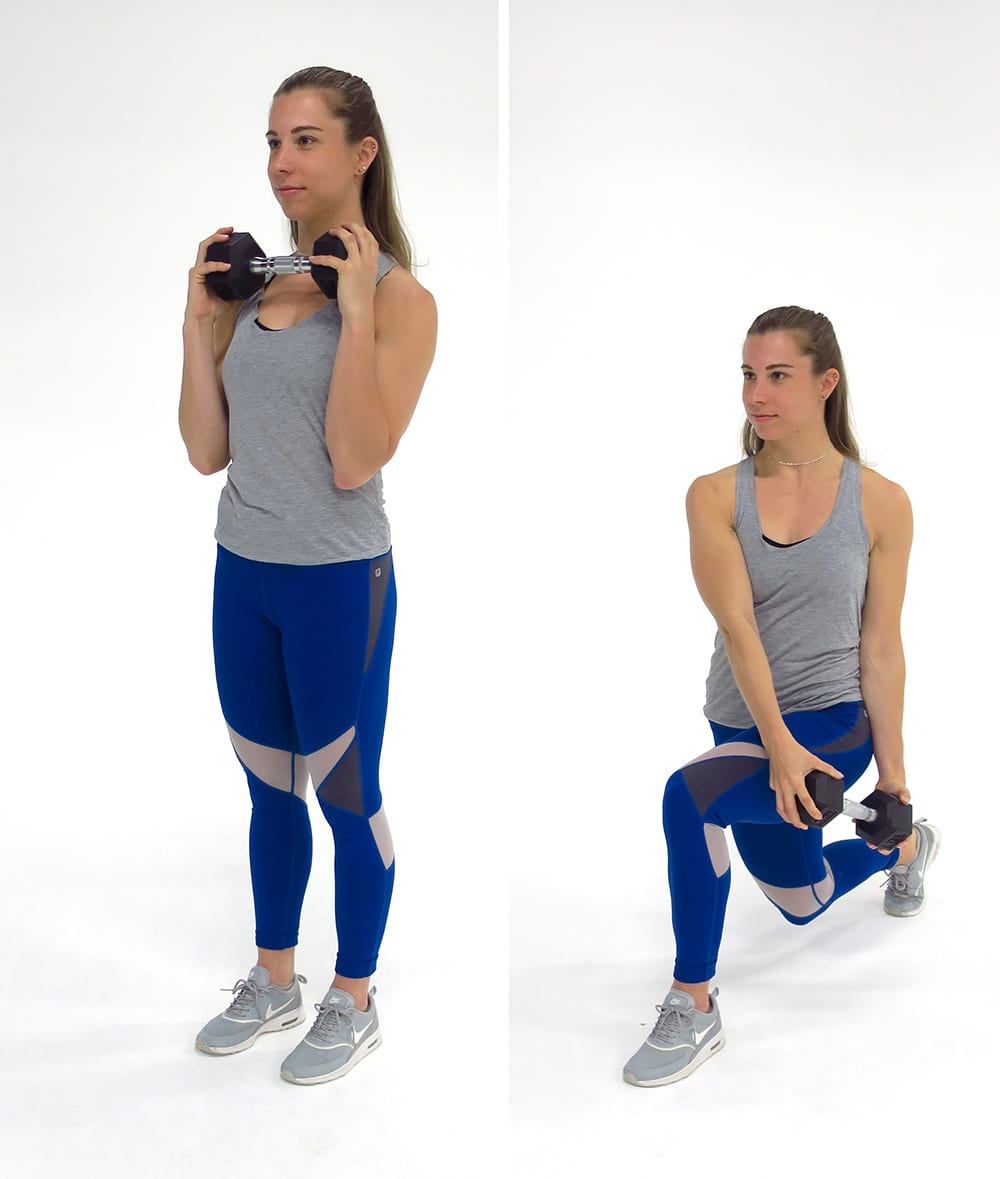
Fully engage your entire core — especially your obliques — as you build strength and power in your lower body with this loaded lunge variation.
- Stand tall with your feet hip to shoulder-width apart, holding a dumbbell with both hands in front of your chest. This is the starting position.
- Keeping your core engaged, simultaneously step your left leg backward into a reverse lunge and lunge and lower the weight to the outside of your right (forward) thigh as if paddling a canoe.
- Return to the starting position and repeat, this time stepping back with your right foot and lowering the weight to the outside of your left thigh.
- Continue alternating legs with each rep.
7. Split Jump
Essentially a jumping lunge, the split jump is a plyometric exercise that can help you build explosive power.
As with all plyometric exercises, make sure you’ve built a strong foundation before you add this move to your routine.
- Stand in a staggered stance with your right foot two to three feet in front of your left foot. Option to hold a pair of dumbbells at arm’s length by your sides (palms in).
- Keeping your chest up, back straight, and core engaged, lower yourself into a lunge position (front thigh parallel to the floor, rear knee bent about 90 degrees), and then jump up so that both feet leave the floor.
- Switch leg positions in the air, landing with your left foot forward.
- Immediately lower your body back into a lunge to begin your next rep.
- Continue alternating legs with each rep.
8. Skater Lunge
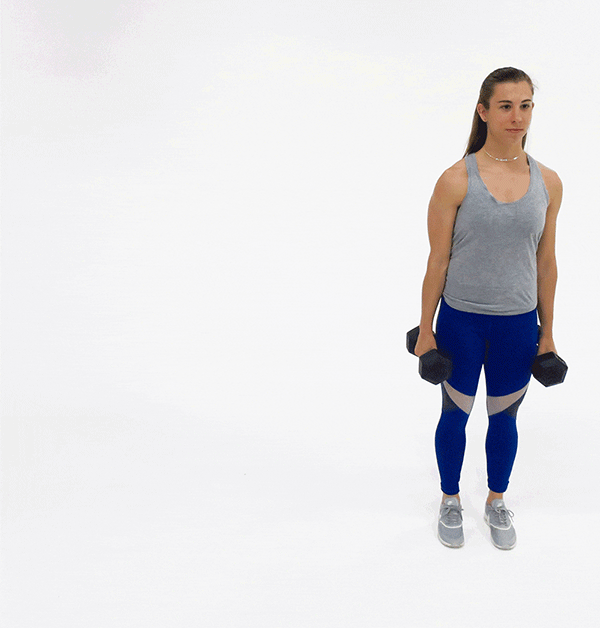
This lunge variation is essentially a jumping curtsy lunge. As a result, it emphasizes the gluteus medius while helping to increase lower body power.
- Stand tall with your feet hip-width apart, holding a pair of dumbbells at arm’s length by your sides (palms in). This is the starting position.
- Hop to your right, pushing off on your left foot and sweeping your arms across your body as you land softly on your right foot.
- Bring your left foot behind and to the outside of your right foot as you lower your body until your right thigh is parallel to the floor.
- Pause, and then repeat the movement to your left, pushing off with your right foot and landing softly on your left foot.
- Continue alternating sides with each rep.
9. Side Lunge to Curtsy Lunge
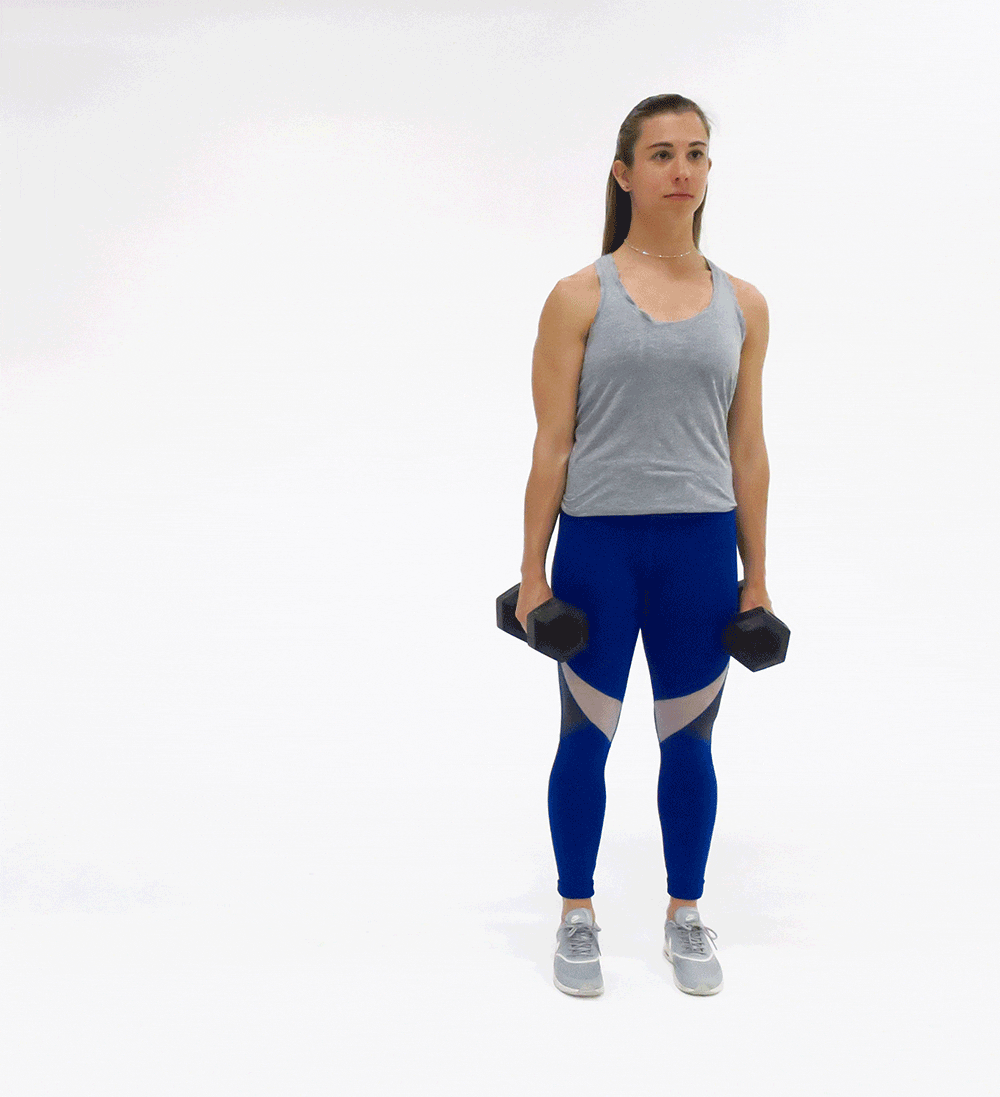
Round out your glute training with this lunge variation that emphasizes the gluteus medius and hip abductors.
- Stand tall with your feet hip-width apart, holding a pair of dumbbells in front of your shoulders (palms in). This is the starting position.
- Keeping your chest up, back straight, and core engaged, take a large step to your right with your right foot.
- Keeping your left leg straight, lower your body until your right thigh is parallel to the floor.
- Pause, and then push off with your right foot and step it behind and to the outside of your left leg to transition into a curtsy lunge, lowering your body until your left thigh is parallel to the floor.
- Rise back up and (without returning to the starting position) step immediately into your next side lunge with your right leg.
- One side lunge and one curtsy lunge equals one rep. Complete all of your reps, and then repeat, this time stepping back and forth with your left leg.
10. Side Lunge to Sumo Squat
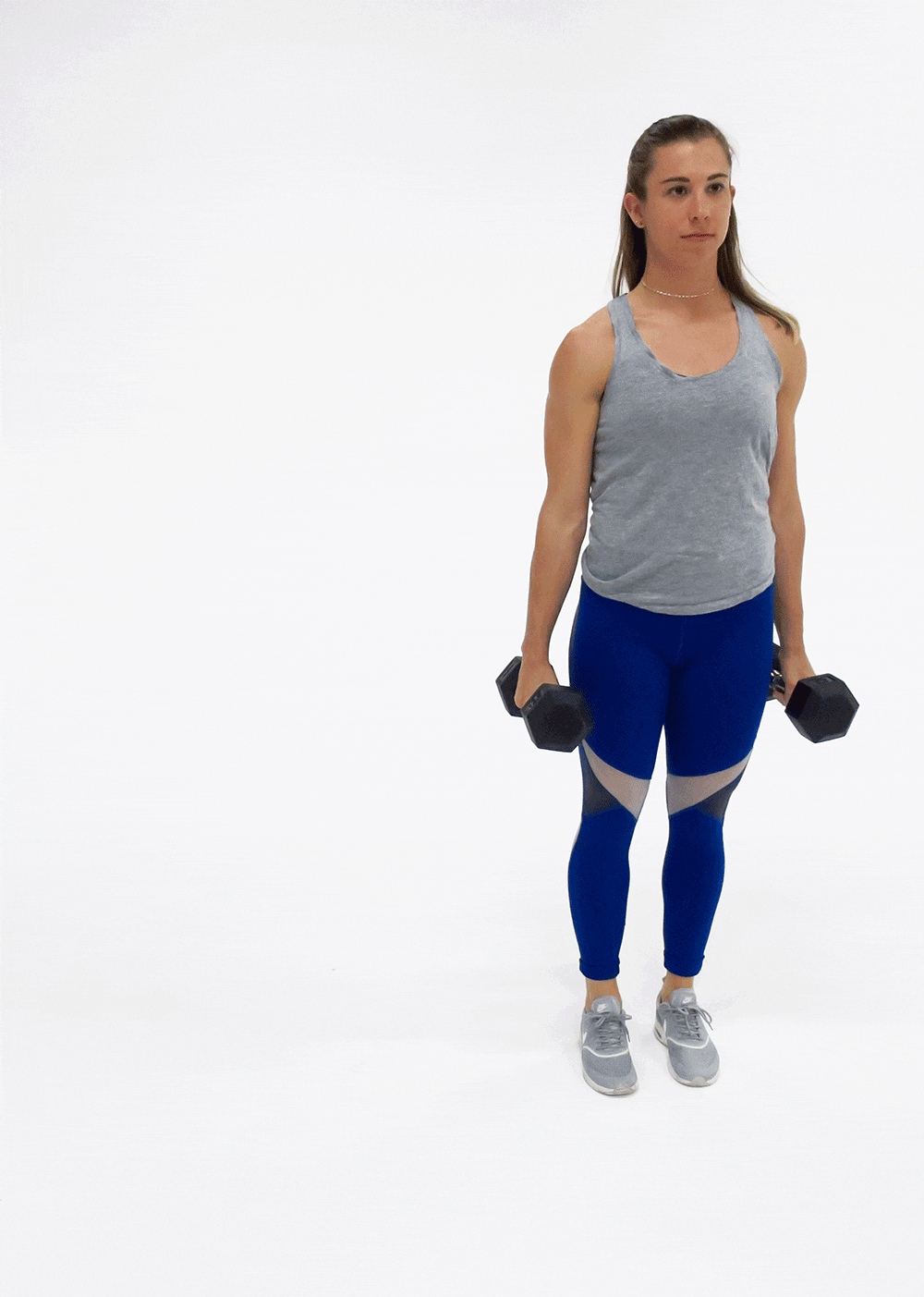
In addition to your glutes, quadriceps, hamstrings, and calves, this combo lunge works your inner thighs. Attack every rep, and you’ll also hike up your heart rate for a great cardiovascular burn.
- Stand tall with your feet hip-width apart, holding a pair of dumbbells by your sides at arm’s length (palms in). This is the starting position.
- Keeping your chest up, back straight, core engaged, and left leg straight, take a large step to your right with your right foot and lower your body until your right thigh is parallel to the floor. Allow the dumbbells to hang at arm’s length on either side of your right leg, but don’t let them touch the floor.
- Pause, then push off with your right foot, bringing it into a wide (greater than shoulder width) stance with the toes of both feet turned outward. Simultaneously lift the dumbbells up to your shoulders, palms in and elbows down.
- Push your hips back, bend your knees and lower your body into a sumo squat (thighs parallel to the floor).
- Return to the starting position, and then repeat the entire sequence, this time stepping out to your left. Alternate sides with each rep.
11. Reverse Lunge Kick
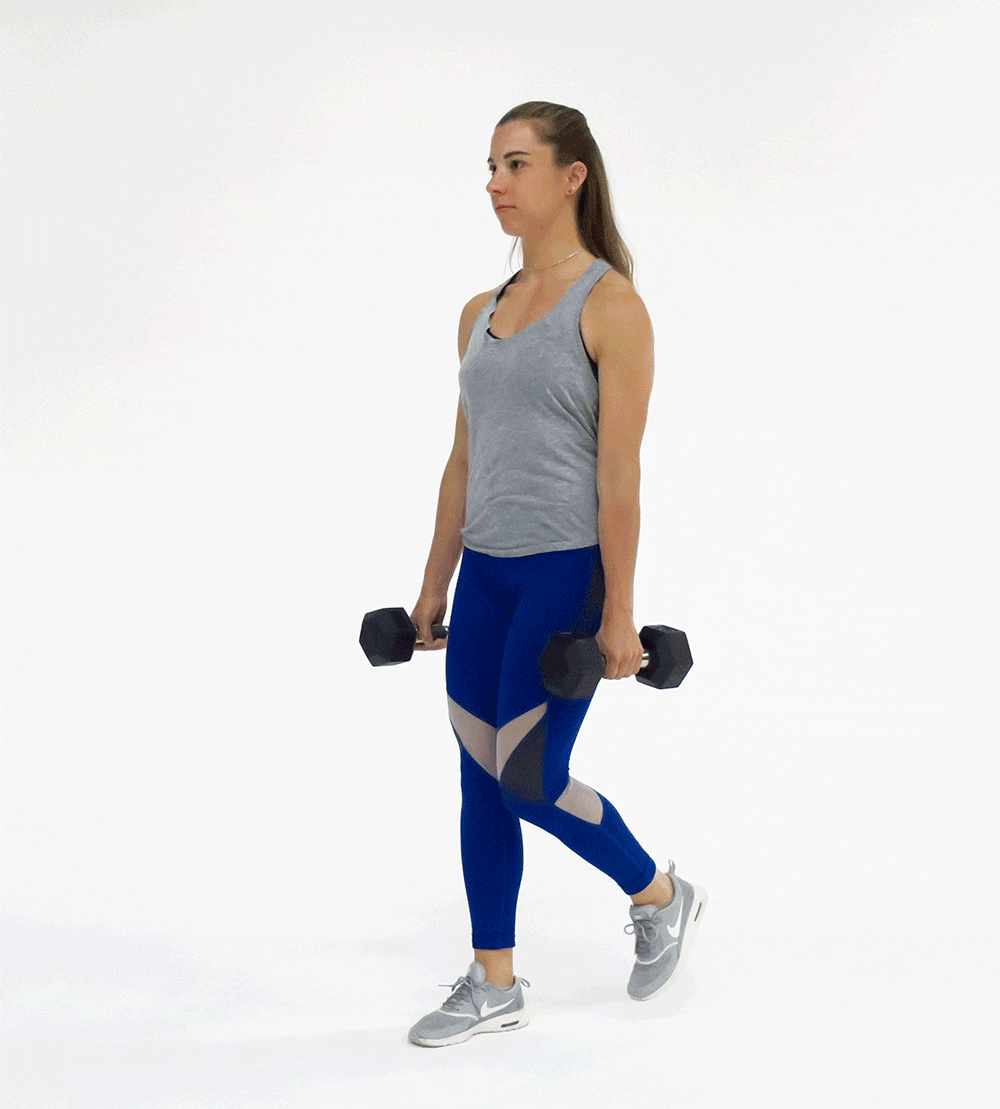
Add a dose of cardio to your lunge with this reverse lunge variation that incorporates a forward kick.
- Stand tall with your feet hip-width apart, holding a pair of dumbbells by your sides at arm’s length (palms in). This is the starting position.
- Keeping your chest up, back straight, and core engaged, take a large step back with your right foot and lower your body until your front thigh is parallel to the ground (your rear knee should be bent about 90 degrees).
- Pause, and then push off with your right foot, kicking it in front of you before immediately stepping back into your next rep.
- Do all of your reps, and then repeat, this time stepping back and kicking with your left leg.
12. Front to Back Lunge
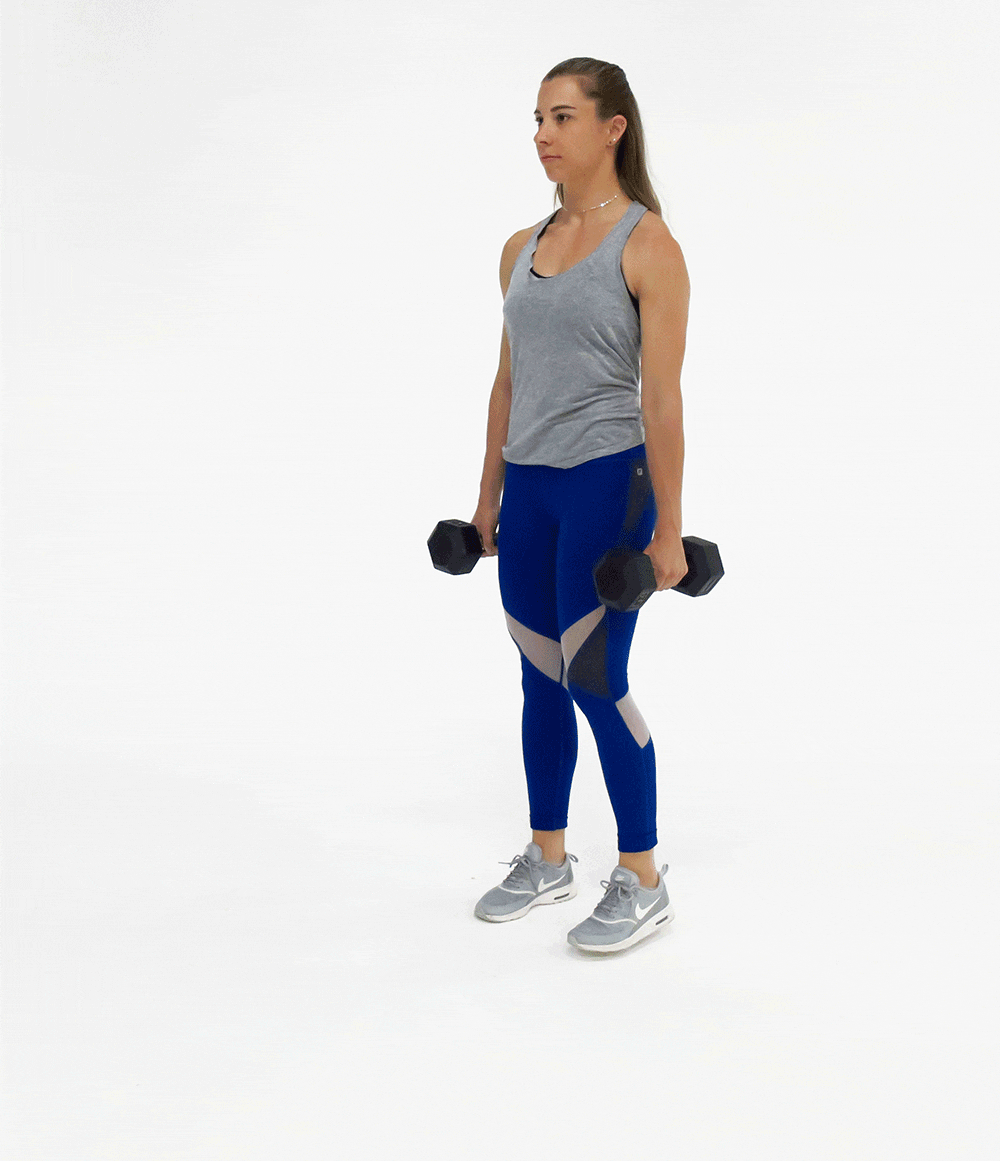
No room to walk around? This combo of the forward lunge and reverse lunge is an effective alternative to the walking lunge.
- Stand tall with your feet hip-width apart holding a pair of dumbbells at arm’s length by your sides.
- Keeping your chest up and core engaged, take a large step forward with your right foot.
- Lower your body until your right thigh is parallel with the floor and your left knee is bent about 90 degrees, just above the floor.
- Pause, and then push off with your right foot, stepping back into a reverse lunge without returning to the starting position.
- That’s one rep. Complete all of your reps, and then repeat with your left leg.
13. Bulgarian Lunge
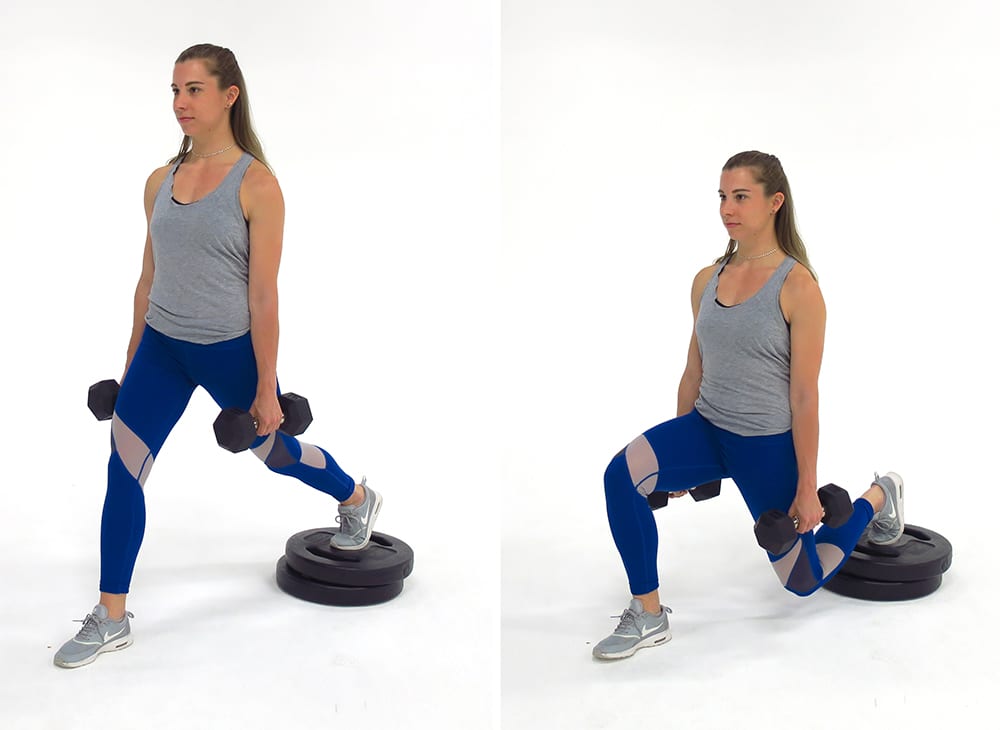
This lunge variation keeps the back foot slightly elevated, increasing the instability of the exercise and placing an even greater emphasis on the quads and glutes of the forward leg.
- Stand in a staggered stance with your right foot forward and your left foot elevated on one or two 25-pound weight plates. Hold a pair of dumbbells at arm’s length by your sides (palms in). This is the starting position.
- Keeping your chest up, back straight, and core engaged, lower yourself into a lunge position (front thigh parallel to the floor, rear knee hovering a few inches above the floor).
- Pause, and then reverse the movement to return to the starting position.
- Do all of your reps, switch legs, and repeat.
Benefits of Lunges
Because lunges are unilateral exercises, meaning they work each side of the body (in this case, the legs) separately, they’re great for improving stability, balance, and coordination.
While all of those are important for day-to-day life, they’re even more vital for athletic endeavors, says Baltimore-based trainer Erica Suter, CSCS. After all, most activities — from running or kicking a soccer ball to mastering “pose of the dancer” in yoga — involve single-leg strength and stability.
What’s more, lunges can function as a great “testing” exercise for anyone. They can reveal if one leg is dominant or stronger than the other, giving you the opportunity to shore up muscle imbalances, Suter says. Doing so both reduces the risk of injury and helps eliminate weak links in big, compound lifts such as the squat and deadlift.
What Muscles Do Lunges Work?
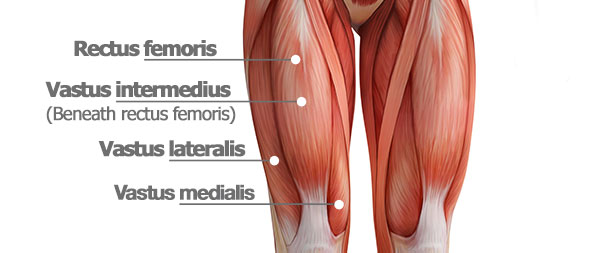
“The lunge targets your quads, but it also works just about every other muscle in your lower body, including your glutes, hamstrings, and calves,” Thieme says.
When performed properly, lunges also engage and strengthen the core.
However, it’s important to realize that different lunge variations emphasize different muscles.
“For example, the reverse lunge increases the demand on the hamstrings,” Thieme notes, “while lateral lunges maximize the engagement of the adductors and glutes — especially the often-overlooked gluteus medius.”
The gluteus medius is situated on the side of the hip. It helps to stabilize the pelvis while assisting with side-to-side motion. This complement to the larger gluteus maximus also helps give a rounder, fuller look to the buttocks.
Lunges vs. Squats
If you love doing squats, you’re probably thinking, “Squats work all of those muscles, too. Can’t I just stick with squats over lunges?”
Nope. “You should include both in your training program,” Thieme says. “They might hit the same muscles, but they work those muscles in different ways, and they each offer unique performance benefits.”
The most notable difference is that because the squat is a bilateral exercise — meaning it works both legs simultaneously — it allows you to move more weight and ultimately build more lower-body strength and muscle compared to the lunge.
But that doesn’t mean the squat is better across the board. As a unilateral exercise, the lunge helps increase muscular stability and coordination to a greater degree than the squat.
“That gives lunges an edge over squats in improving overall athleticism,” Thieme says.
